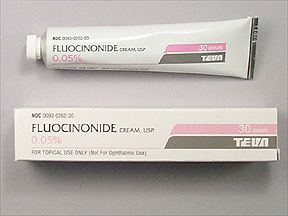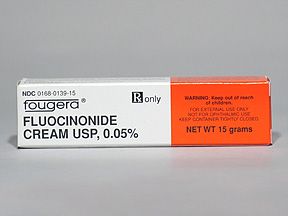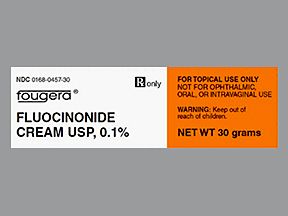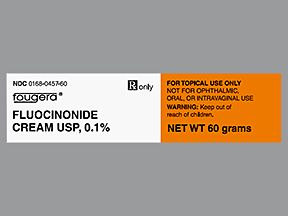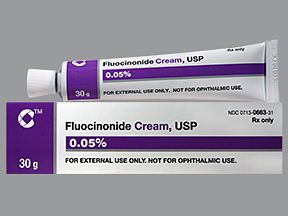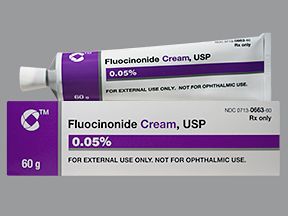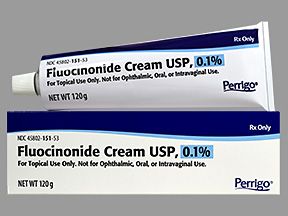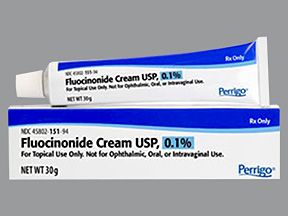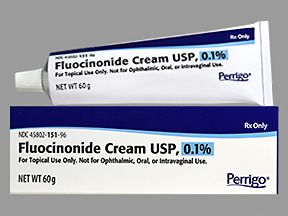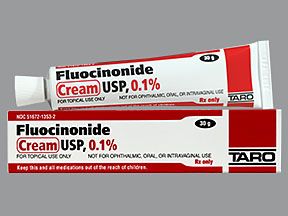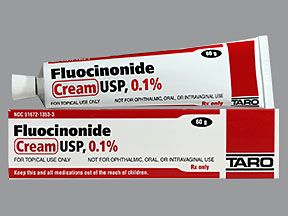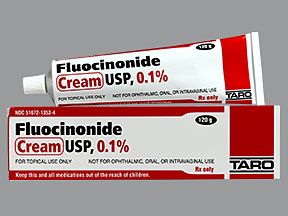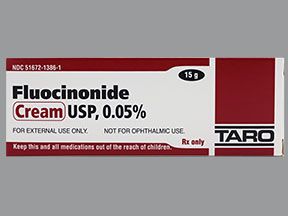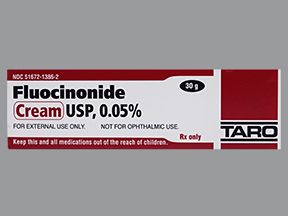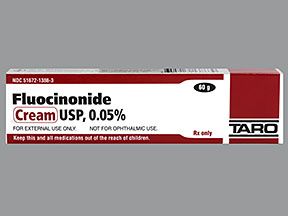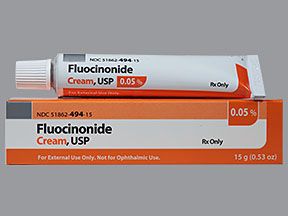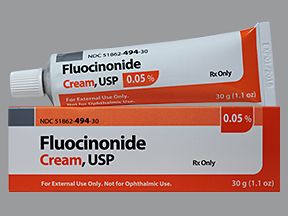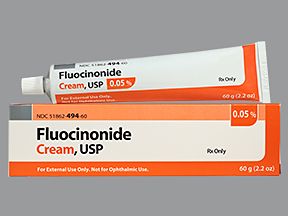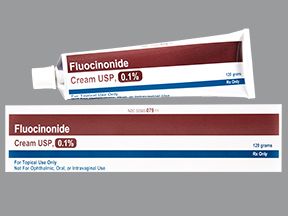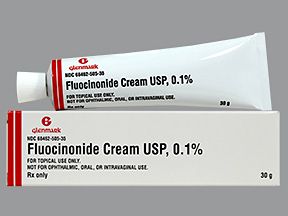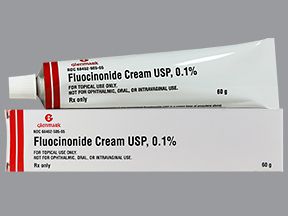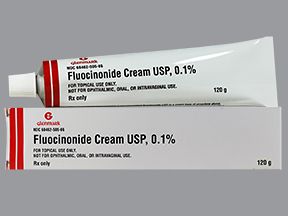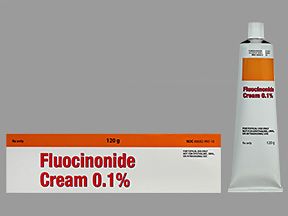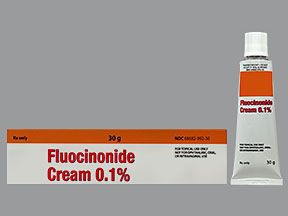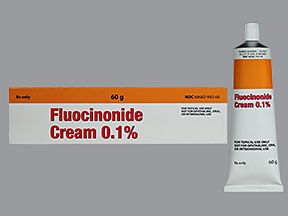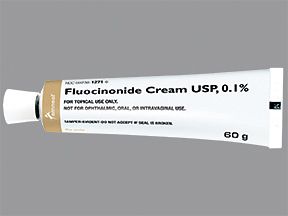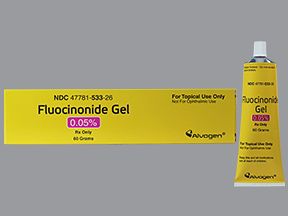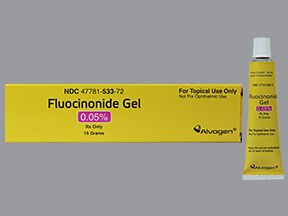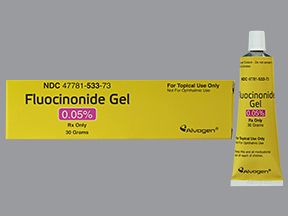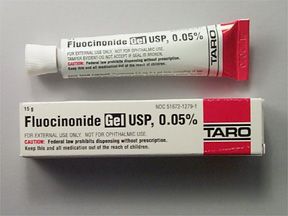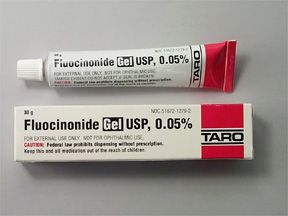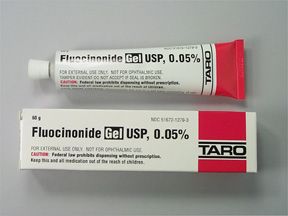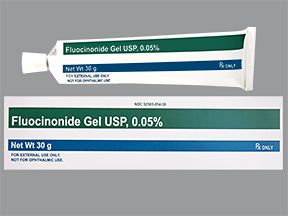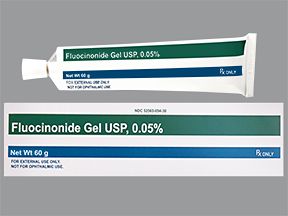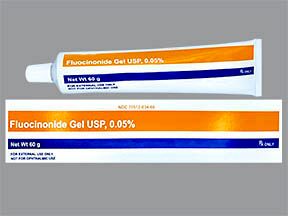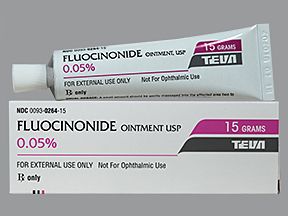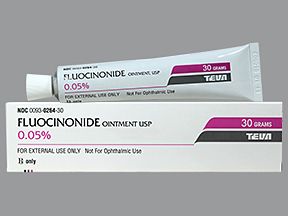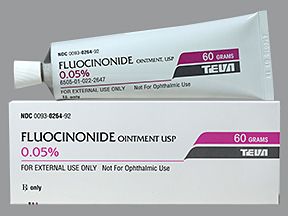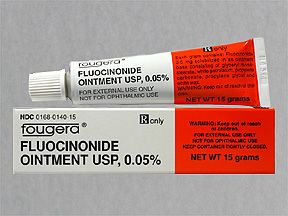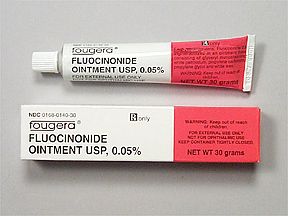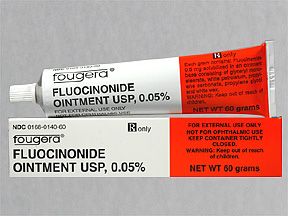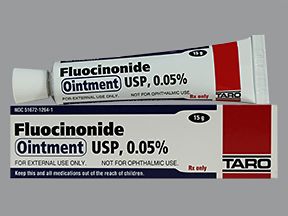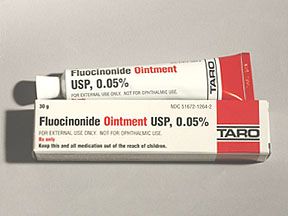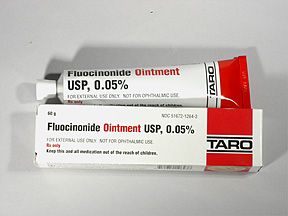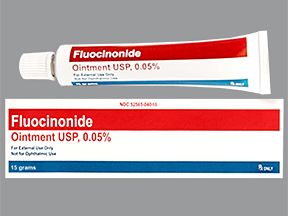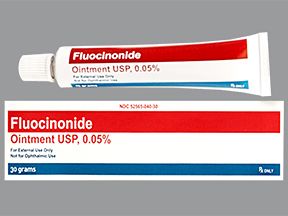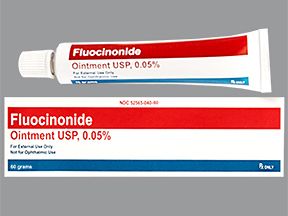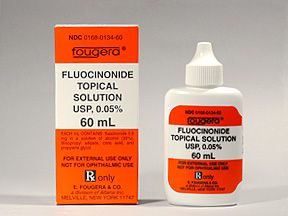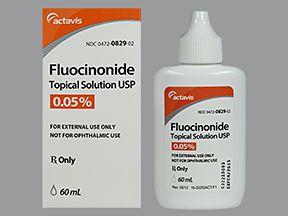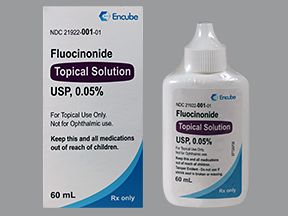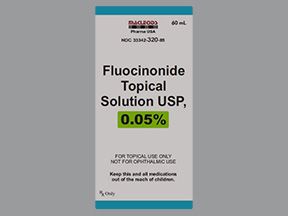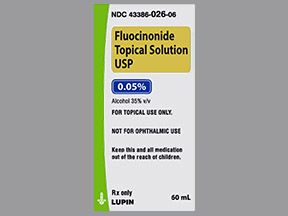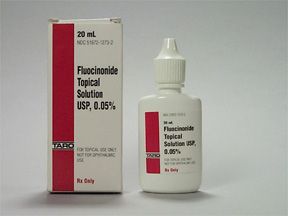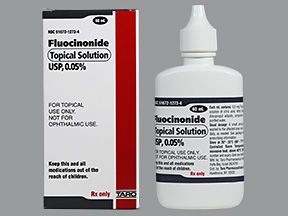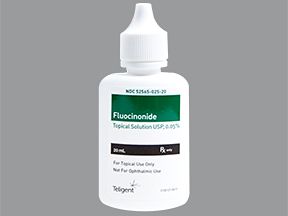Highlights for fluocinonide
- Fluocinonide cream is available as a brand-name drug and a generic drug. Brand name: Vanos.
- Fluocinonide comes in four forms: cream, gel, ointment, and liquid solution.
- Fluocinonide cream is used to treat skin conditions that may cause itching, redness, and inflammation (swelling and irritation). These conditions include allergies, psoriasis, and atopic dermatitis.
- Adrenal insufficiency warning: This drug increases your risk of adrenal insufficiency if you use it for a long period of time (typically more than two weeks in a row) or over a large part of your body. With this condition, the adrenal glands don’t make enough steroid hormones. This condition can be serious. Symptoms can include dizziness, weakness, loss of appetite, or stomach upset. Your doctor may stop this medication if you have symptoms of adrenal insufficiency. This condition can also occur after treatment with this drug has stopped.
- Cushing syndrome warning: Fluocinonide is meant to be absorbed into your skin. However, it may be absorbed into your bloodstream. This can cause Cushing syndrome, a condition where your body makes too much of the stress hormone cortisol. Symptoms of this serious condition include a moon-shaped face and a lump of fat between the shoulders. Cushing syndrome can also cause high blood sugar and high blood pressure. To help prevent this condition, don’t cover your skin with airtight bandages while using this drug. Also, avoid long-term use (typically longer than two weeks) of this drug, and avoid using over large areas of skin unless directed by your doctor.
- Skin infections warning: If you have a current infection or develop a new bacterial or fungal infection, tell your doctor right away. Your doctor may prescribe an antibacterial or antifungal drug. If the infection doesn’t go away, your doctor may stop your treatment with fluocinonide until the infection has healed.
- External use only warning: Avoid getting fluocinonide into or near your eyes. It shouldn’t be used on your face, groin, or underarms. Be sure to wash your hands thoroughly after using this medication.
Fluocinonide is a prescription drug. It comes in the form of a cream, gel, ointment, or solution.
Fluocinonide cream is available as the brand-name drug Vanos. It’s also available as a generic drug. Generic drugs usually cost less than the brand-name version. In some cases, they may not be available in every strength or form as the brand-name drug.
Fluocinonide may be used as part of a combination therapy. This means you may need to use it with other medications.
Why it’s used
Fluocinonide is used to decrease itching, redness, and swelling caused by certain skin problems. These problems include allergies, psoriasis, and atopic dermatitis.
How it works
Fluocinonide belongs to a class of drugs called corticosteroids. A class of drugs is a group of medications that work in a similar way. These drugs are often used to treat similar conditions.
Corticosteroids may work by reducing the body’s production of certain chemicals. These chemicals, called prostaglandins and leukotrienes, cause swelling and itching.
Fluocinonide topical cream doesn’t cause drowsiness, but it can cause other side effects.
More common side effects
The more common side effects that can occur with use of fluocinonide include:
- headache
- skin irritation at the site of application, including:
- burning
- itching
- dryness
If these effects are mild, they may go away within a few days or a couple of weeks. If they’re more severe or don’t go away, talk to your doctor or pharmacist.
Serious side effects
Call your doctor right away if you have serious side effects. Call 911 if your symptoms feel life-threatening or if you think you’re having a medical emergency. Serious side effects and their symptoms can include the following:
- Adrenal insufficiency. Symptoms can include:
- tiredness that worsens and doesn’t go away
- nausea or vomiting
- dizziness
- fainting
- muscle weakness
- feeling irritable
- depression
- loss of appetite
- weight loss
- Cushing syndrome. Symptoms can include:
- weight gain, especially around the upper back and midsection
- slow healing of wounds, cuts, insect bites, or infections
- tiredness and muscle weakness
- feeling depressed, anxious, or irritable
- roundness of the face (moon face)
- new or worsening high blood pressure
- Inflammation of the hair follicles and sweat glands
- More growth of body hair than normal
- New acne
- Loss of skin color
- Skin inflammation (reddening and irritation) around the mouth
- New skin infection
- Thinning of the skin
- Stretch marks
Disclaimer: Our goal is to provide you with the most relevant and current information. However, because drugs affect each person differently, we cannot guarantee that this information includes all possible side effects. This information is not a substitute for medical advice. Always discuss possible side effects with a healthcare provider who knows your medical history.
An interaction is when a substance changes the way a drug works. This can be harmful or prevent the drug from working well. To help prevent interactions, your doctor should manage all of your medications carefully. Be sure to tell your doctor about all medications, vitamins, or herbs you’re taking.
To find out how fluocinonide cream might interact with something else you’re taking, talk to your doctor or pharmacist.
Disclaimer: Our goal is to provide you with the most relevant and current information. However, because drugs interact differently in each person, we cannot guarantee that this information includes all possible interactions. This information is not a substitute for medical advice. Always speak with your healthcare provider about possible interactions with all prescription drugs, vitamins, herbs and supplements, and over-the-counter drugs that you are taking.
This drug comes with several warnings.
Allergy warning
Fluocinonide can cause a severe allergic reaction. Symptoms can include:
- swelling of your eyes, face, lips, throat, or tongue
- hives
- itching
- trouble breathing
- rash
If you develop these symptoms, call 911 or go to the nearest emergency room.
Don’t take this drug again if you’ve ever had an allergic reaction to it. Taking it again could be fatal (cause death).
Warnings for people with certain health conditions
For people with skin infections: If you have a current infection or develop a new bacterial or fungal infection, tell your doctor right away. Your doctor may prescribe an antibacterial or antifungal medication. If the infection doesn’t go away, your doctor may stop your treatment with fluocinonide until the infection has healed.
For people with rosacea or perioral dermatitis: Don’t use fluocinonide to treat rosacea. Also, don’t use it to treat perioral dermatitis.
Warnings for other groups
For pregnant women: Fluocinonide is a category C pregnancy drug. That means two things:
- Research in animals has shown adverse effects to the fetus when the mother takes the drug.
- There haven’t been enough studies done in humans to be certain how the drug might affect the fetus.
Talk to your doctor if you’re pregnant or planning to become pregnant. This drug should only be used if the potential benefit justifies the potential risk.
If you become pregnant while taking this drug, call your doctor right away.
For women who are breastfeeding: It isn’t known if fluocinonide passes into breast milk and causes side effects in a child who is breastfed. Talk to your doctor if you breastfeed your child. You may need to decide whether to stop breastfeeding or stop taking this medication.
For children:
- It hasn’t been confirmed that fluocinonide 0.1% cream is safe and effective for use in children younger than 12 years.
- Children may absorb higher amounts of fluocinonide than adults. This puts them at higher risk of serious side effects. If high amounts of fluocinonide are absorbed by a child’s body over a long period of time, growth and development can be delayed. If your child needs to use this medication long-term (for weeks to months), your child’s doctor should monitor their growth.
All possible dosages and drug forms may not be included here. Your dosage, drug form, and how often you take the drug will depend on:
- your age
- the condition being treated
- how severe your condition is
- other medical conditions you have
- how you react to the first dose
Drug forms and strengths
Generic: Fluocinonide
- Form: topical cream
- Strength: 0.05%
Brand: Vanos
- Form: topical cream
- Strength: 0.1%
Dosage for itching, redness, and swelling that results from skin problems
Adult dosage (ages 18 years and over)
- Fluocinonide 0.05% cream: Apply a thin film to the affected areas 2–4 times per day as directed by your doctor.
- Vanos 0.1% cream: Apply a thin layer to the affected skin areas once or twice per day as directed by your doctor.
Child dosage (ages 12–17 years)
- Fluocinonide 0.05% cream: Apply a thin film to the affected areas 2–4 times per day as directed by your child’s doctor.
Vanos 0.1% cream: Apply a thin layer to the affected skin areas once or twice per day as directed by your child’s doctor.
Child dosage (ages 0–11 years)
- Vanos 0.1% cream: It hasn’t been confirmed if fluocinonide 0.1% cream is safe and effective for use in children younger than 12 years.
- Fluocinonide 0.05% cream: Apply a thin film to the affected areas 2–4 times per day as directed by your child’s doctor.
Disclaimer: Our goal is to provide you with the most relevant and current information. However, because drugs affect each person differently, we cannot guarantee that this list includes all possible dosages. This information is not a substitute for medical advice. Always speak with your doctor or pharmacist about dosages that are right for you.
Fluocinonide cream is used for short-term or long-term treatment. How long you use it depends on the medical condition you have. It comes with risks if you don’t take it as prescribed.
If you stop taking the drug or don’t take it at all: Your symptoms, such as redness and itching, may not improve or may get worse.
If you miss doses or don’t take the drug on schedule: Your medication may not work as well or may stop working completely. For this drug to work well, a certain amount needs to be applied to the affected areas until they’re completely healed.
If you take too much: You could have dangerous levels of the drug in your body. Symptoms of an overdose of this drug can include increased side effects, such as:
- adrenal insufficiency, with symptoms including:
- tiredness that worsens and doesn’t go away
- nausea or vomiting
- dizziness
- fainting
- muscle weakness
- irritability
- depression
- loss of appetite
- weight loss
- Cushing syndrome, with symptoms including:
- weight gain, especially around the upper back and abdomen (stomach area)
- slow healing of wounds, cuts, insect bites, or infections
- tiredness and muscle weakness
- depression, anxiety, or irritability
- roundness of the face (moon face)
- new or worsening high blood pressure
This medication may also cause harm if swallowed. If you think you or your child has swallowed this medication or used too much of it, call your doctor or local poison control center. If symptoms are severe, call 911 or go to the nearest emergency room right away.
What to do if you miss a dose: Apply fluocinonide as soon as you remember. But if you remember just a few hours before your next scheduled dose, follow your regular schedule. Never apply more than the recommended amount, as this would raise your risk of side effects.
How to tell if the drug is working: Your symptoms should improve.
Keep these considerations in mind if your doctor prescribes fluocinonide for you.
General
- Take this drug at the time(s) recommended by your doctor.
Self-management
- Apply fluocinonide to your skin only. Avoid getting fluocinonide into your mouth, nose, and eyes.
- Don’t apply fluocinonide on your face, underarms, or groin area unless told to do so by your doctor.
- Apply only a thin film of the medication. It’s very strong and a small amount is effective.
- Clean and dry the affected area before applying fluocinonide.
- Wash your hands before and after use. If applying to your hands, don’t wash your hands after applying fluocinonide.
- Don’t cover the treated area with bandages or dressing unless told to do so by your doctor.
Storage
- Store fluocinonide 0.1% cream at room temperature between 59°F and 86°F (15°C and 30°C).
- Store fluocinonide 0.05% cream at room temperature between 68°F and 77°F (20°C and 25°C).
- Don’t freeze this medication.
- Don’t store this medication in moist or damp areas, such as bathrooms.
Refills
A prescription for this medication is refillable. You should not need a new prescription for this medication to be refilled. Your doctor will write the number of refills authorized on your prescription.
Travel
When traveling with your medication:
- Always carry your medication with you. When flying, never put it into a checked bag. Keep it in your carry-on bag.
- Don’t worry about airport X-ray machines. They can’t harm your medication.
- You may need to show airport staff the pharmacy label for your medication. Always carry the original prescription-labeled container with you.
- Don’t put this medication in your car’s glove compartment or leave it in the car. Be sure to avoid doing this when the weather is very hot or very cold.
Clinical monitoring
Your doctor will monitor your health while you take this drug. They may check your:
- Hormone levels: In rare cases, fluocinonide may affect your body’s hormone levels. Your doctor may do certain tests to make sure your body’s hormone levels are within the normal range. These tests may include:
- ACTH-stimulation test
- blood cortisol test
- urine free cortisol test
- Growth rate: In rare cases, long-term use (for weeks to months) of fluocinonide may slow a child’s growth. If your child is using this medication, your child’s doctor will monitor their height and growth.
Availability
Not every pharmacy stocks this drug. When filling your prescription, be sure to call ahead to make sure your pharmacy carries it.
Prior authorization
Many insurance companies require a prior authorization for this drug. This means your doctor may need to get approval from your insurance company before your insurance company will pay for the prescription.
There are other drugs available to treat your condition. Some may be better suited for you than others. Talk to your doctor about other drug options that may work for you.
Disclaimer: Healthline has made every effort to make certain that all information is factually correct, comprehensive, and up-to-date. However, this article should not be used as a substitute for the knowledge and expertise of a licensed healthcare professional. You should always consult your doctor or other healthcare professional before taking any medication. The drug information contained herein is subject to change and is not intended to cover all possible uses, directions, precautions, warnings, drug interactions, allergic reactions, or adverse effects. The absence of warnings or other information for a given drug does not indicate that the drug or drug combination is safe, effective, or appropriate for all patients or all specific uses.


